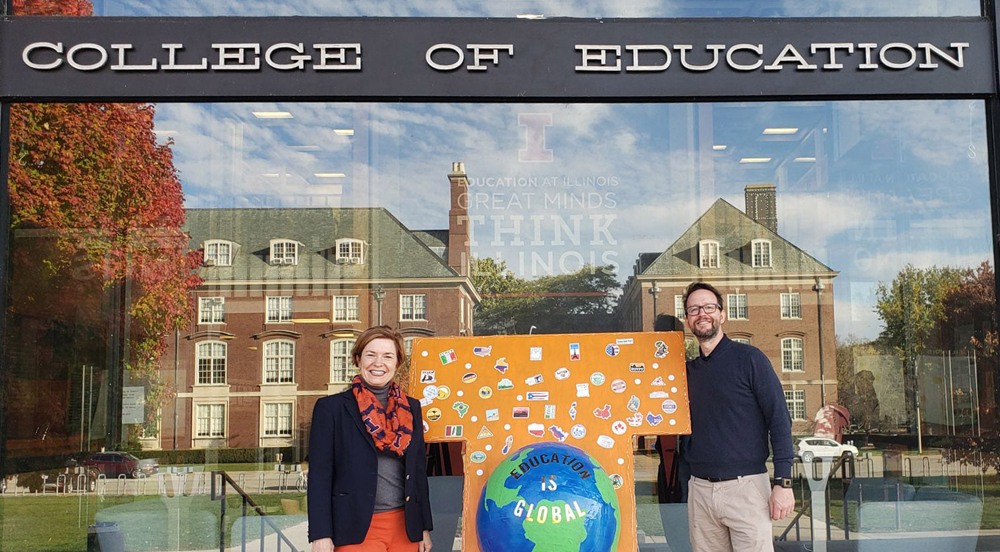For all the talk of increasing racial and ethnic diversity among teachers, there is shockingly little, locally at least, in the way of concrete plans to actively recruit (and subsequently keep) these teachers. Part of this is due to availability; you can’t hire teachers who don’t exist.
“I can’t hire them if they’re not around” may seem like an excuse to justify not hiring teachers of color, but a look at the fall 2020 undergraduate enrollment numbers at UIUC’s College of Education provides some perspective: of the 655 enrolled students, only 44 were Black. This is counting all undergraduates enrolled in education; diving into specific programs reveals even starker numbers. Only seven of those students were enrolled in the elementary education track; only five and four students enrolled in middle grades education for mathematics and literacy, respectively; there were none enrolled in science or social science for middle school.
There are promising signs though: The number of Hispanic undergraduates in education programs has just about tripled in the past decade, rising from 38 in the fall of 2010 to 111 this past fall, while the number of Asian-Americans has held steady (53 in 2010 to 59 recently). These numbers still pale compared to the 402 white undergraduates in education programs. Concerningly, there are no undergraduates who identify as Indigenous American, and there is no way of telling how many, if any students, are Middle Eastern/North African (MENA); by definition, these peoples are considered white, though we’re certainly not treated as such. But that’s a conversation for another day.
To paint a picture of how difficult it may be for schools to hire a teacher of color, consider those seven Black undergraduates studying elementary education. Between Champaign, Piatt, and Douglas county, there are nearly fifty elementary schools. Let’s say that only a quarter of those schools had open positions, that’s still about twelve schools fighting for seven teachers. This is assuming that 1) all seven stick with education and don’t change majors; 2) they all want to stay in the area after graduating; and 3) they are willing to work in schools where they are likely to be the only person of color. And this is just getting them through the door — schools and districts will need to make substantial efforts to retain these teachers as well.
It is worrying, then, that despite these (presumably) known challenges, neither Champaign Unit 4 nor Urbana SD 116 have specific plans for recruiting or retaining teachers of color. While students of color may not be flocking to education programs in droves, it still doesn’t excuse the lack of available information concerning initiatives to hire and keep those who are studying to become teachers.
Unit 4, in its strategic plan released last summer, acknowledges that its teachers are mostly white, unlike the majority of students in its schools, adding that it wants to “aggressively recruit and develop…more teachers who look like and identify with our students.” And this is the extent of it. There is mention of a “Minority Teacher Recruiting & Retention Committee” on the district’s human resources page, though a search through the site doesn’t bring any more information. This group is also noticeably absent from the list of committees on Unit 4’s site. One can find a “Commitment to diversity” page with a “Diversity of Faculty and Staff” link, though following this link only takes the reader to the human resources page listing a few reasons to join Unit 4.
Urbana 116, at least, does have a recruitment and retention plan available to view online, though this is a plan for recruiting and retaining teachers in general, with no specific strategies for teachers of color. This was confirmed when I spoke with the district’s director of human resources, Markesha Parker, and the recruitment and retention specialist, Larry Simmons, who told me that, though they do reach out to HBCUs (historically Black colleges and universities), they are trying to “recruit the best in general, despite what they look like.” Ms. Parker did mention that the district wants to “put people in front of our students who look like them” and noted that they “may need to be more strategic about recruiting Black men and other teachers of color,” adding that the district intends on revisiting and improving its strategy.
Some may applaud these districts’ awareness of their lack of teacher diversity and intentions, but intentions and awareness only go so far when there is little available information as to how they intend to solve these problems. There is nothing to persuade potential teachers of color to join either Champaign or Urbana, and there is nothing explaining the efforts these districts are making to support its current diverse teachers. Like many other facets of education, “We want more teachers of color” is a great sound bite lacking any substance. Both districts would do well to have transparent, detailed plans readily available online if they are serious about their support for teachers of color.
Wassim Elhouar is a recent graduate of the University of Illinois and a writer and educator in the Champaign-Urbana area. He will be starting his doctoral studies this fall in industrial/organizational psychology at Montclair State University.








